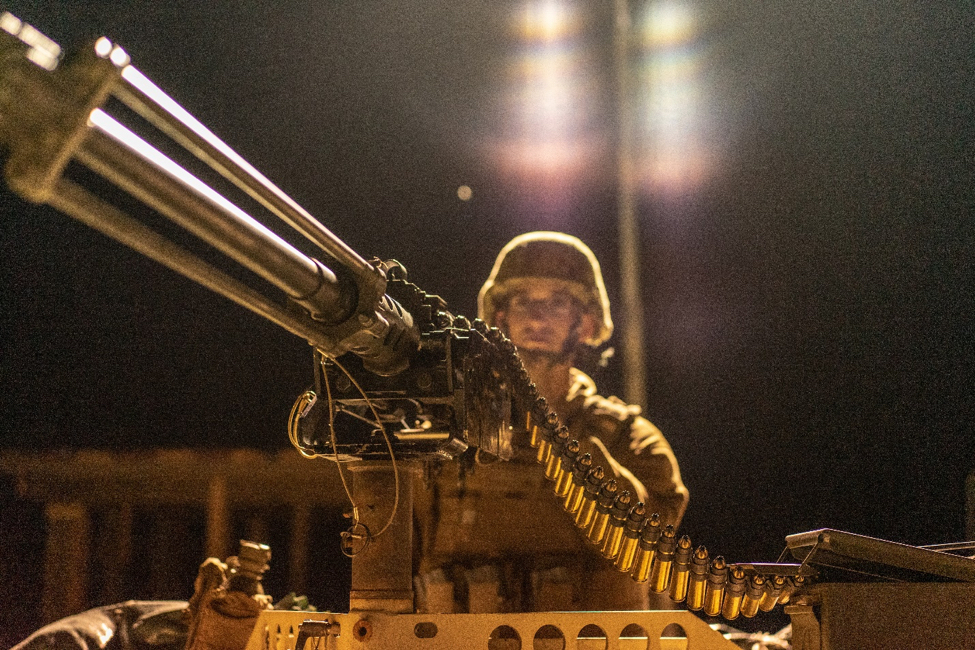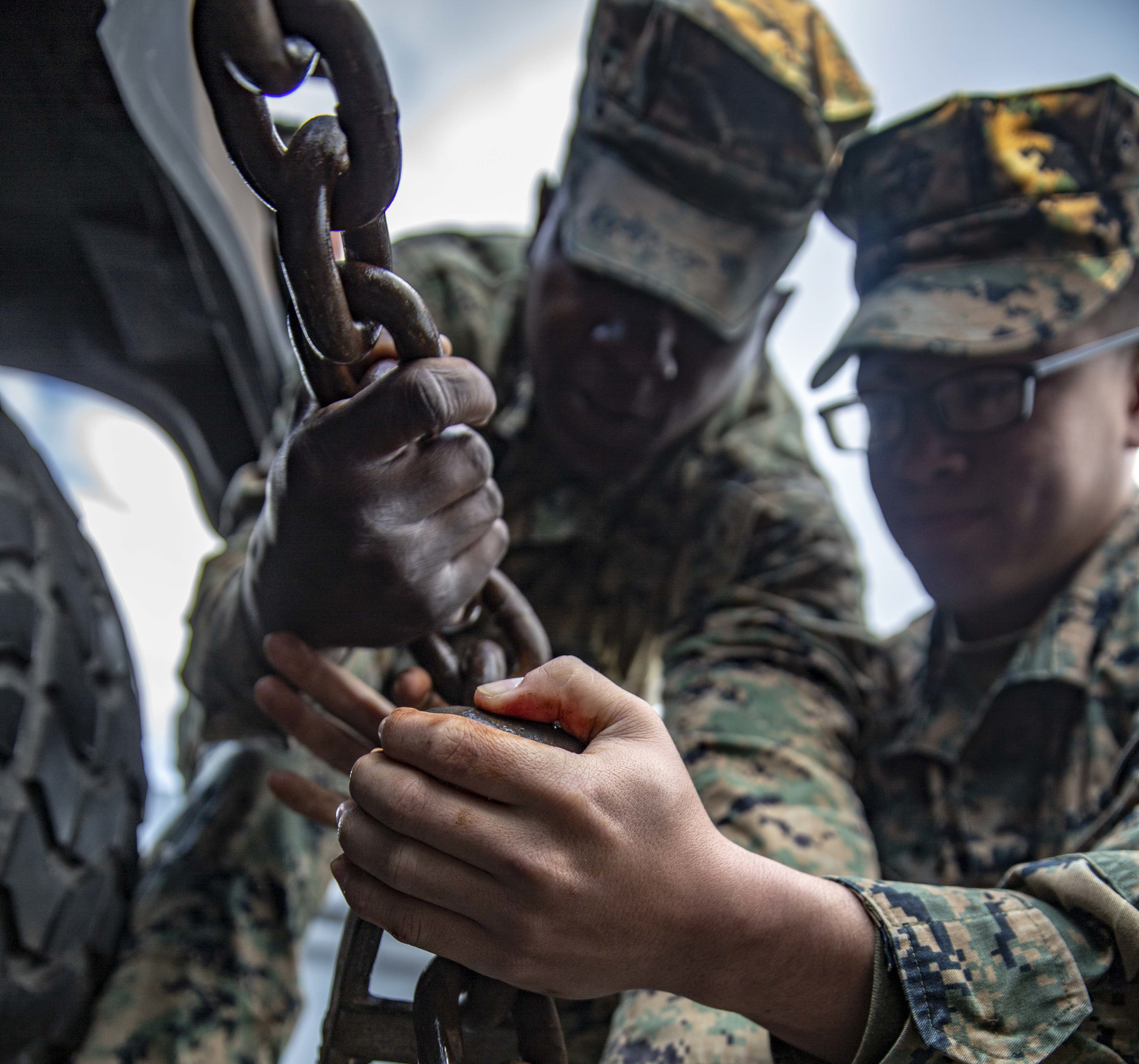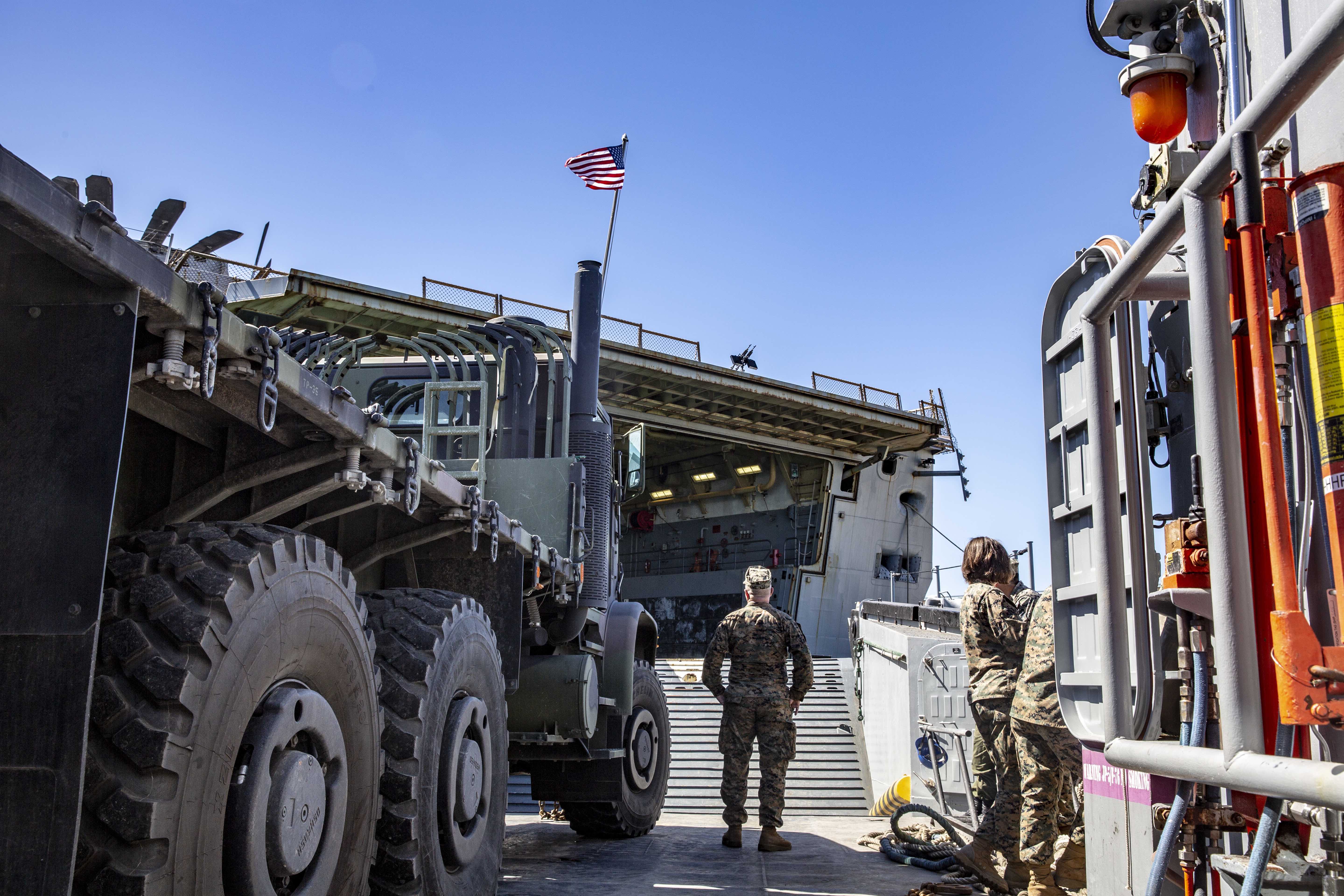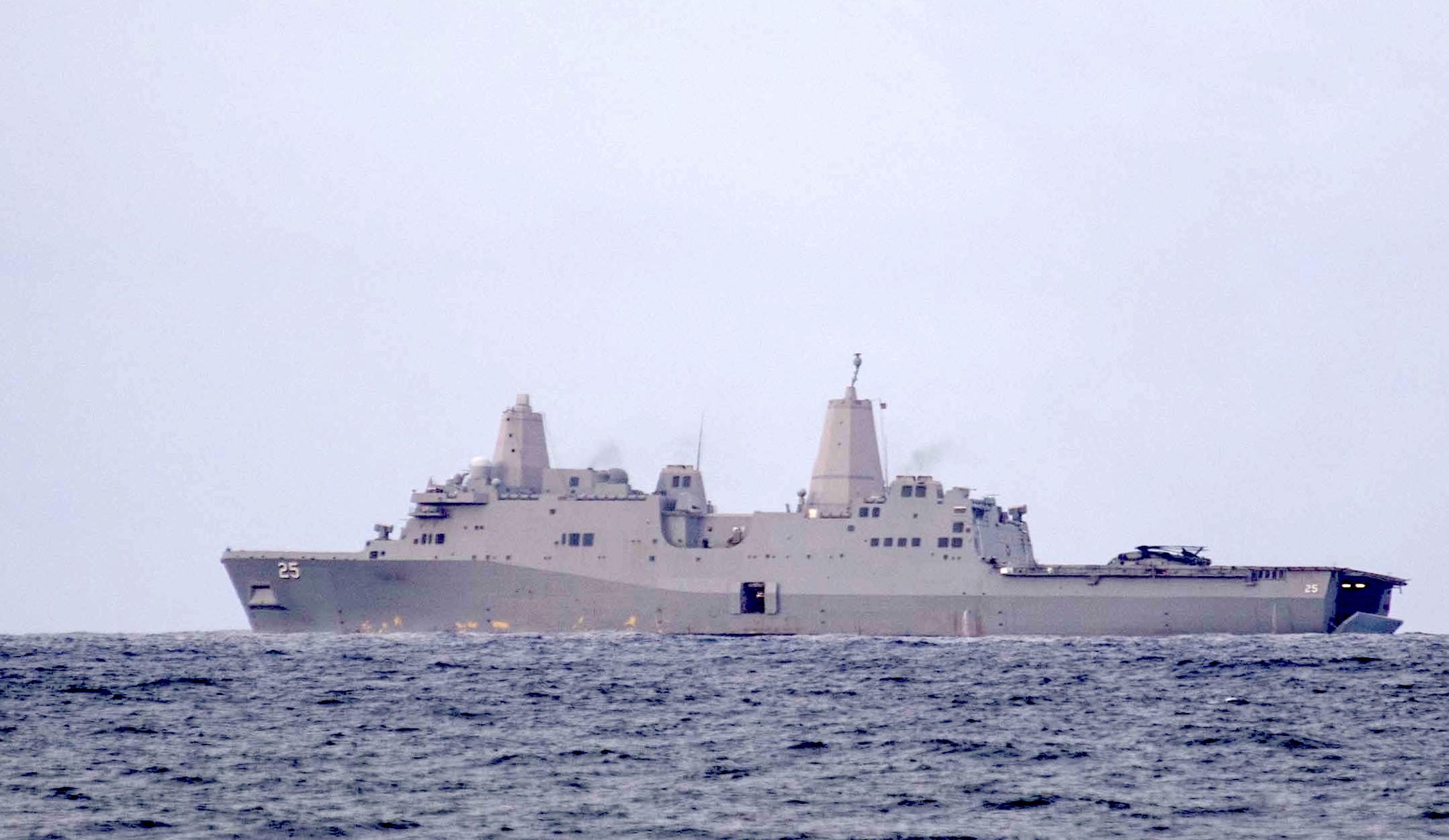
This post has been updated to add additional ships that participated in the exercise.
As amphibious exercise Pacific Blitz 2019 wraps up today, senior commanders already are reviewing after-action lessons and thinking ahead to future exercises that will help develop, train and prepare forces for fights on the move and close to shore.
The exercise, which began March 12 off Southern California, is the result of combining the logistics exercise Pacific Horizon and amphibious exercise Dawn Blitz “to try to start getting at this complicated concept,” Vice Adm. John Alexander, the U.S. 3rd Fleet commander in San Diego, said of the Marine Corps’ Littoral Operations in a Contested Environment (LOCE) concept that involves moving small groups of Marines around on shore or between islands. “It’s a different way of doing business.”
Pacific Blitz involved 5,000 Marines and sailors with I Marine Expeditionary Force and 5,000 sailors spread across several installations, including Naval Base San Diego, Marine Corps Base Camp Pendleton, Marine Corps Air Station Miramar, Naval Surface Warfare Center Port Hueneme and Naval Air Station Point Mugu. Amphibious transport dock USS Somerset (LPD-25), amphibious transport dock USS New Orleans (LPD-18), guided-missile destroyer USS Michael Murphy (DDG-112), maritime prepositioning ship USNS William R. Button (T-AK-3012) and aviation logistics ship SS Curtiss (T-AVB-4) also participated.
Officials say that naval amphibious forces will face and fight capable near-peer adversaries in the future, and they must maintain “sea control” so forces can operate and maneuver across the vast battlespace. One likely battleground is Indo-Pacific region that’s home to many islands, U.S. allies and trading partners, and potential threats from China and Russia.

Marines are expected to play a greater role in sea control, so I MEF and Expeditionary Strike Group (ESG) 3 tested that during Pacific Blitz with a different command-and-control construct compared to traditional amphibious naval forces that fall under the “blue” forces of the Commander of Amphibious Task Force or “green” forces of the Commander of Landing Force.
The exercise is helping determine “how do we get to Littoral Operations in a Contested Environment, and how do we maneuver quickly to remain untargeted in that fashion,” Alexander said in an interview with USNI News. “We’ve got some work to do,” he added.
“We need to… make sure we have tactics, techniques and procedures to execute in that dynamic environment,” Alexander said, adding “it’s challenging to dynamically maneuver small groups of people in and around and keep track of them, and make sure that they are providing the overall objective of sea control and logistics movement.” A large command center ashore “forms a static footprint that’s targetable,” he noted.
Pacific Blitz focused on command and control, organization and staff planning, along with building expeditionary advance sea bases (EABO), a secondary concept that falls under LOCE.
“It’s getting after some new operational constructs,” Lt. Gen. Joseph Osterman, the I MEF commander at Camp Pendleton, told USNI News.
I MEF integrated with San Diego-based ESG 3 during the scenario-driven field training exercise. Osterman and his staff had a greater role in sea control and in command and control of forces ashore and at sea.
“Let’s say you do have a shooting capability for counter-surface fires,” he said. “How are you integrating those radars to know where the target is, or whose got the authority to actually authorize a launch of a weapons system? If you sink a capital ship, it’s a big deal. So how do you make sure all of that is integrated properly?”
Marines traditionally go ashore en masse and retain their own command and control. For Pacific Blitz, “instead of phasing control ashore in a typical way of when we put Marines in – taking them off ships and putting them on land – I’ve got it set up this time around where we never phase control ashore,” Osterman said, and instead, “that Marine unit is actually working for the composite warfare commander in a sub-surface, surface or anti-air capability to achieve sea control.” So Marines in the landing force might be tasked with helping maintain sea control by targeting striking enemy forces, firing rockets or anti-ship missiles or using unmanned aerial systems, for example.

The exercise addressed the CNO’s latest strategy – A Design for Maintaining Maritime Superiority 2.0 – for a more lethal, agile and capable future force. Goals include maturing the distributed maritime operations concept, posturing logistics capabilities ashore and at sea that support and sustain the fleet globally, and creating resilient ways to refuel, rearm, resupply and repair.
So Marines and naval expeditionary forces were spread across simulated “islands” and expeditionary advanced bases or advanced naval bases, all designed to help facilitate sea control. “It’s meant to be dynamic because it’s meant to keep us untargeted in a contested environment,” said Alexander. But that also make logistics and resupply more challenging.
“We are optimized to move it in big quantities” of fuel supplies, he said. “Now we’re having to figure out how do we move it in smaller quantities but utilize it in a fashion that … is dynamic, quickly moveable and untargetable.” It’s not easy relocating equipment, such as smaller fuel bladders and pumps, to support maneuvering, distributed forces at sea and ashore.
The logistics of expeditionary advance base operations, such as resupply, refueling, medical care and aviation support, is relatively new to Marines. “If you’re going to put a transient base forward, an EAB, how do you get enough fuel there to operate aircraft for 72 to 96 hours, whatever it might be?” Osterman said. “It’s not quite as exciting as shooting missiles or stuff like that, but it’s one of those fundamental things that if we can’t get it right, we’re not going to be able to do the mission we’ve got to do.”
So at Port Hueneme, naval forces did a strategic offload and onload of Maritime Prepositioning Force ship Button, which “hadn’t been done in a long time,” said Alexander. Arrival-and-assembly teams with 1st Marine Logistics Group set up pipelines for potable water. At Camp Pendleton, Navy Expeditionary Combat Command (NECC) sailors and Seabees in a task force under I MEF patrolled the harbor and established an Expeditionary Medical Facility — the first time it was pulled from a maritime prepositioning ship. “They were able to set it up, check the gear and make sure it would be all ready to go in high-end environment,” Alexander said.

On San Clemente Island, NECC sailors loaded an exercise torpedo on a P-8 Poseidon maritime surveillance aircraft that “was in an expeditionary role, which was kind of cool,” Alexander said. “But what we also saw was a big footprint for loading gear for that, and we need to get technologies that can do that on a smaller footprint.” Marines and sailors set up a joint forward arming and refueling point, where aircraft brought in fuel and crews filled fuel bladders that, in turn, refueled fixed- and rotary-wing aircraft.
At sea, Marines on aviation logistics ship Curtiss fixed and maintained aircraft. “We’re not actually going to land aircraft on there and work on them, but they are actually fixing components while they’re at sea,” Osterman said, “and we’re going to provide the supply.”
Alexander said Pacific Blitz provided a good opportunity for 3rd Fleet to build its warfighting and command and control capabilities and operate in an expeditionary role for future exercises such as Dawn Blitz.
“I think this is a prime opportunity to work an expeditionary (maritime operations center) posture or agility ashore somewhere, and run our staff through an expeditionary model ashore,” he said.
“We’re trying to close that expeditionary maritime operations center gap, so this could be an opportunity to do that,” he said, adding, “this has the ability to become the premier 3rd Fleet/I MEF blue-green exercise every other year.”





